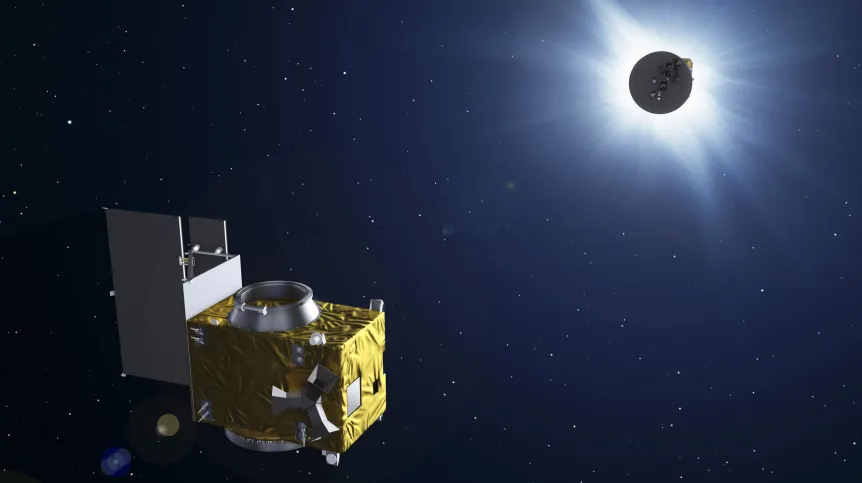
A groundbreaking space mission named Proba-3 promises to reveal unprecedented insights into the Sun’s inner corona, a region previously studied only during rare and brief solar eclipses.
Launched on December 5, 2024, the innovative mission led by the European Space Agency (ESA), will provide unprecedented observations of the Sun's dynamic outer layers, including the middle and lower corona, from space.
“Proba-3 will allow us to observe the Sun’s corona in ways that were never before possible,” said Dr. Marek Stęślicki, a heliophysicist at the Space Research Centre of the Polish Academy of Sciences (PAS) and a key member of the Science Operations Centre for the mission. “The middle corona is where coronal mass ejections (CMEs) are accelerated, and where the solar wind is formed—phenomena that impact space weather and, by extension, Earth’s magnetic field.”
The core innovation of the Proba-3 mission lies in the synchronized formation of two satellites orbiting the Earth at a precise 150-meter distance. These satellites, the Coronagraph Spacecraft (CSC) and the Occulter Spacecraft (OSC), will work in tandem to create an artificial solar eclipse, offering a clear view of the Sun’s corona, which is usually obscured by its intense brightness.
The Coronagraph Spacecraft, weighing 340 kg, carries a high-tech coronagraph designed to observe the faint solar corona, while the smaller 200 kg Occulter Spacecraft will deploy a disk that blocks out the Sun’s direct light. This setup will allow the instruments to capture detailed images of the solar corona for about six hours each day, the duration of the orbit during which the Sun is occulted by the disk.
“This artificial eclipse will give us a view of the solar corona as if we were observing it from a much larger telescope, without the scattering effects that ground-based coronagraphs suffer from,” Dr. Stęślicki said. Ground-based telescopes often struggle with scattered light, caused by diffraction within the optical elements of the instrument, which can obscure the faint corona.
The Proba-3 mission solves this issue by sending two spacecraft into space, where the absence of the Earth’s atmosphere allows for clearer and more accurate observations. The key to the mission's success lies in the precise positioning of the occulter disk and its ability to block only the Sun’s disk, enabling the instruments to observe both the outer and middle corona in high detail.
The Proba-3 mission is not just about solar science; it will also play a crucial role in understanding space weather. CMEs, large bursts of solar plasma and magnetic fields, are often accelerated in the middle corona and can affect the Earth’s magnetosphere, sometimes leading to geomagnetic storms that disrupt communications, satellite operations, and even power grids.
With the ability to observe the middle and low parts of the solar corona, Proba-3 will provide vital data on the origins of CMEs and the solar wind. These phenomena are responsible for the auroras seen in polar regions and play a significant role in shaping the space weather that affects Earth.
The mission will provide daily six-hour observations of dynamic phenomena, allowing scientists to study these events in real time. According to Stęślicki, the data will "significantly deepen our knowledge of the sources of space weather and help us better understand the Sun’s influence on our planet."
The Proba-3 satellites are designed for autonomous operation. Rather than being directly controlled from Earth, the satellites will rely on onboard systems to maintain their precise formation and adjust their positions as necessary. These systems will ensure that the spacecraft maintain a constant 150-meter distance, with an accuracy of just 3 millimeters.
The Proba-3 mission will follow an elliptical orbit around Earth, completing one orbit every 20 hours. At its closest point, the satellites will be 600 km from Earth, and at its farthest, 60,000 km. This orbit shape minimizes the gravitational forces exerted on the satellites, reducing the amount of fuel needed to maintain their formation.
The Proba-3 mission involves collaboration between 40 companies and institutions from 14 countries, including seven Polish entities. Engineers from the Space Research Centre PAS were instrumental in designing and constructing the coronagraph, while scientists from the Centre’s Solar Physics Department developed the scientific software for the mission.
The mission’s data will be sent from the satellites to the ground station in Santa Maria in the Azores, from where it will be forwarded to the Science Operations Centre in Redu, Belgium, for analysis. During the mission's initial commissioning phase, the satellite systems will undergo checks to ensure everything is functioning correctly before the first scientific data is received.
Proba-3 is expected to continue operating for approximately two years before its fuel runs out. After that, the Moon's gravity will slowly pull the satellites back toward Earth, where they will burn up in the atmosphere no later than three years after the mission's launch.
The Proba space missions, which began with Proba-1 in 2001, are experimental missions designed to test new satellite technologies. Proba-3, however, marks a significant leap in our ability to study the Sun in unprecedented detail, potentially transforming our understanding of solar phenomena and their impact on Earth.(PAP)
PAP - Science in Poland, Anna Bugajska
abu/ bar/ lm/ kap/
tr. RL













